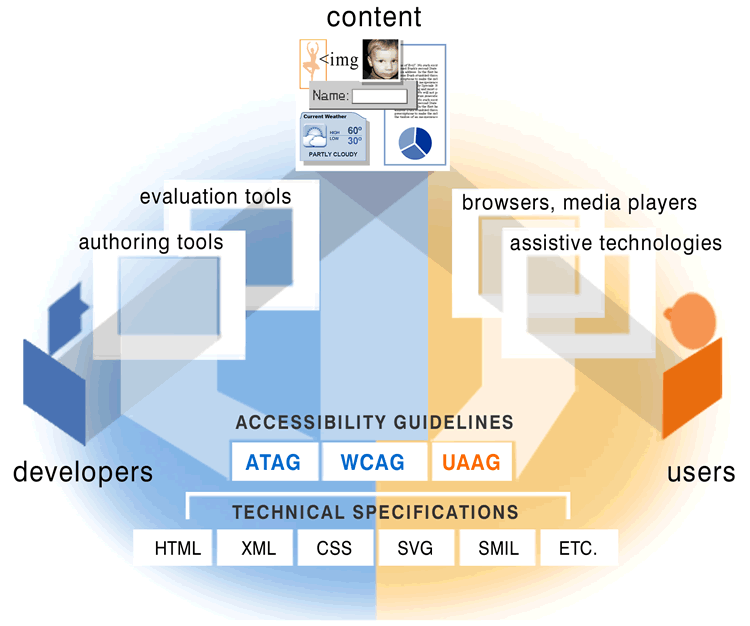What is ADA Website Compliance?
15% of the population, and therefore your website viewers, have some form of disability that can lock them out from using your website.
The ADA (Americans with Disibilities Act) added legal standards that require websites to be ADA compliant just as building construction needs to be ADA compliant.
Reasons to be ADA Website Compliant
- It’s the law: All Federal, some state and local agencies and companies creating websites for these agencies. Access-Board.gov Guidelines and Standards – Final Rule Updating the ICT Standards and Guidelines
- Accessibility, Visibility and Maintenance: Accessible websites tend to have better search results, lower maintenance expence and greater visibility.
- It demonstrates your consideration for people with disabilities.
Overall Reason for the ADA Website Compliance Ruling
In the same way that a non-wheelchair accessible building puts people relying on wheelchair transportation at a disadvantage, potentially locking them out, a non-ADA compliant website puts impaired viewers at a disadvantage, potentially locking them out from a website’s content.
Bringing your website up to ADA compliance makes it available to impaired viewers.
Benefits of ADA Website Compliance
- Greater website visibility
- Wider audience
- Legal compliance
- Better website rankings on Google and other search engines
Who Needs Website ADA Compliance?
- All Federal Agencies
- Some state and local agencies
- Companies creating websites for the above agencies
- Companies desiring better website visibility on the internet
- Website owners interested in complying with the law
- Website owners interested in having a website equally available to all viewers
- Companies looking for a new competitive edge
- Web developers wanting to create ADA compliant websites and attain a competitive edge
What Happens if Your Company Website is not ADA Website Compliant?
Remember how it was at first suggested by Google that it was important to have a mobile compliant website? The next step came when Google downgraded all websites that were not mobile compliant.
It is now suggested that websites be ADA compliant. Guess what’s going to happen next, based on the above scenario?
The Solution
Get your company website up to ADA website compliant now, before it becomes a huge business-limiting issue!
Why the Need for Website ADA Compliance?
Technologies that assist impaired website viewers rely on the source code of a web page. A website’s CSS style sheet, on the other hand, reorganizes the source code creating a different, more visually appealing order and presentation of items on the page.
For this reason, if you’re a visually impaired viewer relying on a reader pulling content from the website’s source code, the content you receive may be scrambled in comparison with the content non-visually impaired viewers expeience on the actual web page.
Example of CSS Styled Columns:
Products
Telephones
Computers
Protable MP3 Players
Locations
Idaho
Wisconsin
New York
Source Code (used by impaired technology readers). Message scrambled, meaningless:
Products Locations Telephones Computers Portable MP3 Players Wisconsin Idaho New York
And this is only a small piece of the problem. Include issues experienced by people who cannot see colors, people who cannot hear…etc.
The Challenge of Creating ADA Website Compliance
Making your website available to impaired viewers involves a complex restructuring of code.
W3C C6: Positioning Content Based on Structural Markup
There are automated tools that can get you part-way to ADA compliance, but they still require some complex manual assistance.
WebAim Resources
W3C Web Accessibility Initiative
Accessibility Fundamentals

Our Strategy to Create ADA Website Compliance
Here’s what we do to make your website ADA Compliant:
- Conduct a full scan of your website and correct current issues on your website.
- Evaluate your website using multiple tools
- Complete the manual checks we identify
- Make regular ADA scans that take into account ADA regulation updates and fix new issues as they occur.
- Review the WCAG standards so you are aware of the issues.
- Install the NVDA screen reader and browse your website.
- Draft an ada compliance policy and publish it on your website. This will make it clear to your users that you care about Web Accessibility and that you are working to comply with the requirements.
- Provide an ada compliant online form, email address or phone number for users to report issues that they may encounter.
The plan outlined above is based on the recommendations set forth by the Department of Justice for State and Local websites. Refer to the voluntary action plan section.
How to Become Website ADA Compliant Now?
Fortunately, MarketingDepartmentLV.com has a website ADA compliance program. We take the complexity off of your hands and make your website ADA compliant.
Our specialty Website ADA Compliance program makes us:
- Highly competitive
- More thorough
- We work with your existing web developer or marketing department
- We partner with web designers, web developers and graphic artists to help ensure their websites are ADA compliant
We focus on continuous improvement. Make a plan and take regular steps to comply.

